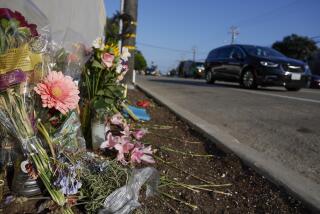Bike Helmet Law Deemed a Successin Its 1st Year
- Share via
NEWPORT BEACH — Lia Rousset, 17, was bicycling to school last month when she hit “some kind of little pole” and was knocked unconscious.
“That day, I was thinking, ‘I don’t want to wear my helmet,’ ” recalled the Newport Harbor High School junior. “I had a ski hat on, and the helmet was getting in the way, but I decided to wear it anyway.”
She’s glad she did. As she convincingly found out, a helmet “could make or break your life.”
Lia’s escape from serious head injury is just what doctors, law enforcement officials and state legislators say the state’s bicycle helmet law was designed to do. Now, at the end of the law’s first year, physicians say they’re seeing more youths who wear helmets and sustain fewer head injuries.
The bicycle helmet law, which took effect last January, prohibits a person younger than 18 from operating a bicycle, or riding as a passenger, on public streets, bikeways and trails without the protective device.
As of Sunday, violators could face a maximum $25 fine that parents or guardians would be liable for.
“We’ve seen a substantial increase in the number of children admitted for bicycle-related injuries who were wearing a helmet,” said Dr. Gary Goodman, co-director of pediatric intensive care at Children’s Hospital at Mission Hospital Regional Medical Center in Mission Viejo. “We would like to think it’s due to the law.”
Records at Children’s Hospital show in 1993, one out of 19 children admitted for bicycle injuries wore helmets. From January to September this year, five out of 14 children admitted for bicycle injuries wore helmets; seven did not, and it was unclear in two cases.
“I think there’s certainly been a significant increase in awareness,” Goodman said. “From our own anecdotal evidence, the vast majority of kids who get admitted to the hospital not wearing helmets have sustained more serious injuries.”
The California Highway Patrol reports that more children wore helmets this year than last and that the number of deaths and injuries has declined.
In Orange County, from January, 1993, to July, 1993, all nine local youths killed in bicycle accidents were not wearing helmets. Out of 772 injured, only 74 were wearing helmets.
From January to July this year, five children were killed and only one was wearing a helmet. Of 722 injured, 114 were wearing helmets.
Officials hesitate to make a connection between the decrease in deaths and injuries to increased use of helmets.
“Whether or not those are normal fluctuations or whether they’re due to usage is really tough” to determine, said Steve Kohler, CHP spokesman in Sacramento. “We need to have a couple more years to see if there’s any correlation.”
However, doctors say they have seen children who wore helmets come into emergency rooms with less serious injuries.
“Some of the kids who we’re seeing with bike injuries are helmeted,” said Dr. Patrick Romano, a pediatrician at UC Davis Medical Center, where many children are treated for bicycle injuries. “They’re still coming in with extremity injuries, but they’re not as bad as they would be without a helmet.”
According to the Children’s Advocacy Institute, a helmet can reduce severe head injury by 85%.
“It’s been well documented that a helmet is protective,” said Dr. Phyllis Agran, a UC Irvine pediatrics professor. “Once a serious head injury occurs, a person may not recover.”
Doctors say much of the increase in helmet usage can be attributed to a massive push by schools to educate students about the importance of bicycle safety.
In conjunction with local law enforcement agencies, Children’s Hospital of Orange County presents “Sprocket Woman,” a 20-minute program free to all Orange County schoolchildren in kindergarten through second grade.
Sprocket Woman, played by Julie Wagener, the hospital’s childhood injury prevention program manager, dresses in a black and white spandex bike shirt, shorts and cape.
“We’re seeing over 11,000 children a month, teaching the little ones to follow the rules of the road, put helmets on properly and ride on the right side of the road,” Wagener said. “The kids all put their hands on their pretend handlebars and they look right, left, right.”
Another 45-minute program targets third- to sixth-grade students. It is more detailed and focuses on night riding, the danger of having friends ride on handlebars and helmet safety standards, Wagener said.
Helmet costs have also dropped in 1994, said Steve Barrow, legislative director for the Children’s Advocacy Institute, but parents unable to afford $30 to $100 helmets can get them for much less.
In Orange County, school principals identify children who may not be able to afford helmets and give them purchase orders filled by Children’s Hospital of Orange County. So far, more than 3,000 helmets have been distributed.
Safe Moves, based in Marina del Rey, is the largest educational bicycle safety program in the country. The group sells helmets for as low as $10, said director Pat Hines. They also have the only helmet with a blinking red light on the back that can be seen 800 to 1,000 feet away, she said.
The state’s campaign to save lives will take a different approach in 1995, when there will be added penalties for failing to wear a helmet.
Although police will be able to issue fines, it’ll be up to an officer’s discretion to dole out a suitable punishment. Officers can either keep giving verbal warnings or issue more severe punishments.
Citations where the child must appear in Juvenile Court with parents and a maximum fine of $25 can also be levied, said John De Haan of the La Palma Police Department.
“Even though the law is in effect, we know there are times when the child cannot afford a helmet or is not aware of the law,” De Haan said.
The first violation will result in a verbal warning; the second offense--a written warning in the form of a Juvenile Referral Notice--may require the child to attend bicycle safety classes with his or her parents.
A third offense, a citation, will require the child to appear in Juvenile Court with his or her parents and a maximum fine of $25 will be levied.
“We have seen a substantial increase in children wearing helmets, but there are still enough out there that do not,” Newport Beach police Sgt. Andy Gonis. “If a situation warrants a citation, we’ll issue one. A follow-up letter will also be sent to the parents.”
Most parents whose children bike to school are aware of the law, since individual schools in Newport Beach, Fullerton, La Habra and South County have imposed their own helmet rules. But some parents don’t like it.
Susan Rousset, Lia’s mother, is “happy that she wore her helmet, but I feel like it’s up to the person to decide whether or not they’re going to wear it.”
(BEGIN TEXT OF INFOBOX / INFOGRAPHIC)
Helmet as a Shield
In the five-year period between 1989 and 1993, 92% of the deaths and 93% of the injuries suffered by bicyclists in Orange County were to those not wearing helmets. During the first seven months of this year, there have been five fatalities; there were nine in the comparable period last year.
FATALITIES
Orange County
Year Helmet No Helmet Total 1989 0 13 13 1990 3 10 13 1991 0 9 9 1992 1 7 8 1993 0 10 10 Five-year total 4 49 53
Statewide
Year Helmet No Helmet Total 1989 5 112 117 1990 11 121 132 1991 7 108 115 1992 12 110 122 1993 12 121 133 Five-year total 47 572 619
*
INJURIES
Orange County
Year Helmet No Helmet Total 1989 100 1,656 1,756 1990 155 1,657 1,812 1991 114 1,547 1,661 1992 110 1,439 1,549 1993 128 1,243 1,371 Five-year total 607 7,542 8,149
*Statewide
Year Helmet No Helmet Total 1989 863 15,742 16,605 1990 1,061 15,883 16,944 1991 1,126 15,320 16,446 1992 1,255 14,495 15,750 1993 1,291 13,082 14,373 Five-year total 5,596 74,522 80,118
Source: California Highway Patrol
(BEGIN TEXT OF INFOBOX / INFOGRAPHIC)
Helmet Tips
California law requires any bicyclist younger than 18 to wear a helmet. How to find the right one:
* Fit: Place helmet squarely on head so front sits right above eyebrows. It should be snug, not tight. It should never be worn too loose or tipped back on the head.
* Straps: Prior to each ride, helmet straps should be checked to ensure proper fit. Side plastic piece should fit just under ears on both sides, with one strap in front of ear and one behind. Buckle should be positioned right under chin.
* Final check: Helmet should not move more than half an inch in any direction. With the helmet on and tightly fastened, attempt to remove it by rolling backward and forward.
* Care: Do not use solvents or paints on a helmet because they contain chemicals that could cause damage. Use only mild soap and water to clean.
* Standard: Helmets must meet the Snell Memorial Foundation B-90 (SNELL) or American National Standard Institute (ANSI Z90.4) performance standards for bicycle use. The standards will be identified by a sticker on the inside of the helmet.
Source: Children’s Hospital of Orange County
More to Read
Sign up for Essential California
The most important California stories and recommendations in your inbox every morning.
You may occasionally receive promotional content from the Los Angeles Times.










